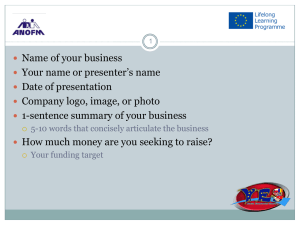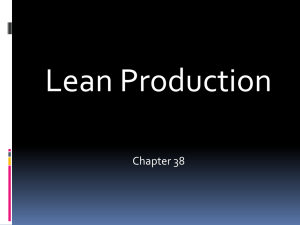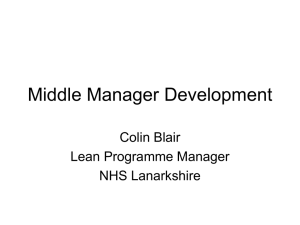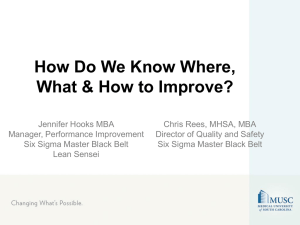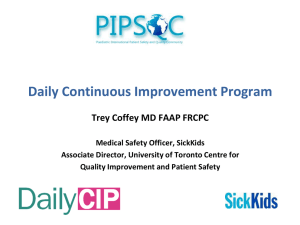Leadership Principles: January 14
advertisement
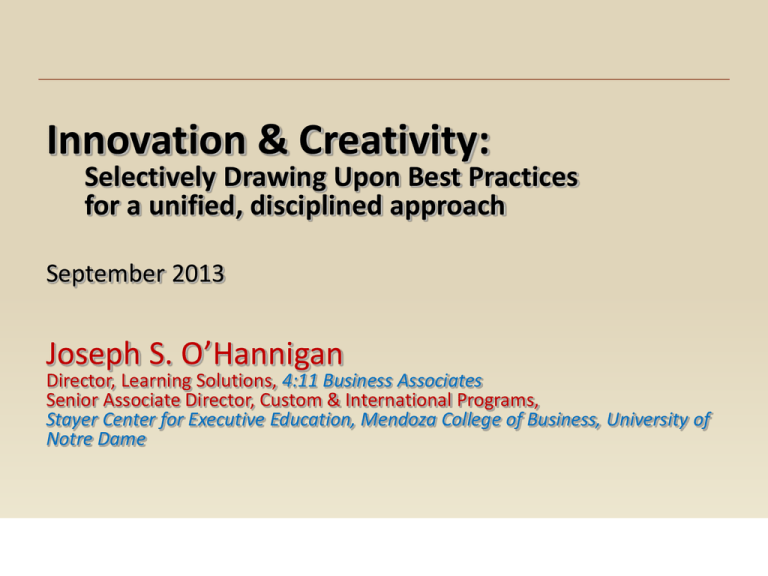
Innovation & Creativity: Selectively Drawing Upon Best Practices for a unified, disciplined approach September 2013 Joseph S. O’Hannigan Director, Learning Solutions, 4:11 Business Associates Senior Associate Director, Custom & International Programs, Stayer Center for Executive Education, Mendoza College of Business, University of Notre Dame Objectives & Outcomes Provide a powerful new framework See the world differently Lead innovation & change more effectively Leverage your native ability to be creative Integrate powerful tools & techniques Create a dynamic new network with other leaders Review & Look Ahead • Creativity & Innovation: It is within YOU o What do we mean by “creativity?” By “innovation?” o Why are some people and organizations so good at this? o Exploding some myths about innovation • Do NOT focus on your products and services o Really. Everyone focuses here. Don’t. o Broaden your view to see all TEN areas to innovate (Products & Services are just 2) • Some of the best: creating a unified, disciplined approach to innovation o There are hundreds of tools and models and stories • Start with the Ten Types • Then on to effective approaches Levels of Innovation Common Business definitions Lean Design definitions Extension of product/service Extension New model, finish, design Incremental New to Company Breakthrough New to World Disruptive Multiple types, even with small innovations, can produce Breakthrough and Disruptive results! What areas might YOU Innovate? © 2013 Doblin; Deloitte Consulting LLP Recall: Lean Thinking • Focus on differentiating VALUE from WASTE (Everyone is a “Waste Detective”) “Doing More and More with Less and Less, While Coming Closer and Closer to Giving the Customer Exactly What is Wanted” (Toyota Production System) 6 A Lean Innovation Approach • Using similar “Lean” thinking, we apply tools and concepts to the “fuzzy front end” of the Product Development Process to: Identify & Differentiate Value from Waste Give the customers exactly what they want Reduce the time to market Provide innovation focus 7 Apply Lean Innovation Tools *derived from 40 years of innovation tools and models *organized by Bart Huthwaite’s Institute for Lean Design • Bart Huthwaite, Lean Design Coach • Founder, Institute for Lean Design 8 The “Mountain Model” 1. End In View – “What, Why & When” 2. Obstacles – Boundaries & Hurdles 3. Strategy – Ten Types End In View Hurdles – Value Creation & Waste Prevention 4. Strategy Metrics – Measurement System & Baselines 5. 6. Metrics Tactics – Innovative Tools Action Plan – 90-day “What, Who & When” Tactics Action Plan Special thanks to Bart Huthwaite, Sr. and the Institute for Lean Design 9 Begin with the End in View Why? – First step in bridging the gap from where you are to where you want to go. – Makes sure everyone is climbing the same mountain. – Builds “common ground.” 10 Boundaries vs. Hurdles No painter begins with an unlimited canvas… …This allows us to identify the limits of the task at hand. Boundaries are fixed and cannot be changed. Hurdles are challenges that can be overcome if the correct resources are brought to bear 11 Deliver Optimum Value, Prevent Lifecycle Waste -ilities, or Value Brothers Wasteful -ings or Gremlins The LEAN DESIGN EQUATION… “Optimize Strategic -ilities, Minimize Evil -ings” 12 All Customers Crave Eight Primary Values… Customer Primary Values Performability Affordability What It Means Will the product perform functionally the way I expect? Will it be within my cost expectation? Featureability Will it have the features that enhance its functions to provide me added benefits? Deliverability Will it be ready for me when I want it? Usability Maintainability Durability Imageability Can I quickly and easily install it, learn how to use it? How easy will it be for me to keep in service? Is it robust enough to withstand the abuse myself, and others give it? Will it convey the image of quality and prestige I desire? 13 Eight Primary Values Every Company Seeks… Company Value What It Means Profitability Will the product deliver profits quickly & at a level acceptable to our company? Investability Will it require investment in people & equipment beyond expectations? Riskability Will it expose our company, either today or tomorrow, to excessive risk? Produceability Do we have, or can we acquire, the skills, experience, and equipment to build the product? Marketability Will we be able to sell it easily using our existing distribution channels? Growthability Does the market for the product offer significant growth and/or market share expansion? Leveragability Will it enable us to enter new growth markets? Respectability Will it convey the image of quality and prestige we desire? 14 Measuring the -ilities and -ings : •Market Opportunities Performability Imageability •What Your Products/Services Lack Affordability •Opportunities to Reduce Cost •Where You Differentiate Featureability Durability Deliverability Maintainability Useabiilty 15 Scoring the -Ilities Rating 9-10 7-8 5-6 3-4 1-2 -Ility Value Level Extremely high value. Sets the standard for the industry High value. Superior to that of most competitors Acceptable. Meets expectations most of the time Low value. Frequently does not meet expectations Extremely low value. Well below that of all competitors 16 Identify Opportunities Imageability Durability Performability 10 9 8 7 6 5 4 3 2 1 0 Repairability Affordability Featureability Deliverability Integrateability 17 Maintain Differentiation… Performability 10 9 8 Imageability Affordability 7 6 5 4 3 2 1 Durability 0 Featurability Maintainability Deliverability Useability Product 1 Product 2 18 Customizing the –ilities Makes Strategy a Part of the Language Company #1 Company #2 • • • • • • • • • • • • • • Imageability Knowledgeability Dell-ability Innovatability Credibility Breadth-ability Sensible Indulgence Easy Integrated Solution Install-ability McDonald’s-ability Flexibility Trust-ability Target-ability Dependability Products & Services are becoming obsolete the minute they are introduced… The Three Sharks of Marketplace Technology Competition are eating the value in our products, services & organizations… 20 Three Sharks Exercise to “See the Future” Step - Now (months/years ) Stretch - Tomorrow ( months/years ) Marketplace Does your design strategy address all the Eight Primary Values? Are you delivering too much? Too little? What are the top 57 changes you anticipate in your customer’s Eight Primary Values? Technology Does your design take advantage of all existing technology? Are you pushing the technology too far? What new technologies do you anticipate emerging? Do you have the capability to develop these internally? Competition How competitive are you today? What are your differentiators? Are there any new competitors who may try to enter your market space by offering a “simplified” solution compared to yours? Leap - Future (months /years ) Are there any “disruptive” marketplace changes on the horizon? Are there any “disruptive” technologies emerging in the distant future that could obsolete your entire business? Would a merger of competitors endanger your market position? Are overseas producers a threat? 21 7 Design Flaws that Add Cost & Reduce Reliability Seven Evils Complexity Description Many different processes required to deliver the product’s value both on factory floor and for the customer’s use. Precision Solution requiring precision at the outer limits of manufacturer’s ability to produce the product or customer’s ability to use it. Variability Specification of difficult to control processes on the factory floor or in the customer’s domain Sensitivity Solution easily flawed during factory operations or in the customer’s domain Immaturity Use of solution not previously validated for a specific application Danger Solutions with potential dangerous impact on humans or environment High Skill Solutions requiring high degree of training and experience 22 Scoring the -ings -Ing Waste Level Rating 9-10 Intolerable. Highest waste in the industry. 7-8 Excessive. Worse than most competitors. 5-6 Tolerable. High, but controllable. 3-4 Low. Minimum impact on cost & quality. 1-2 Extremely low. Well below that of all competitors 23 Measure the Evil –ings like the -ilities 24 Using the Cube to Brainstorm Company Ilities Customer Ilities - Performability - Affordability - Featureability - Deliverability - Usability - Maintainability - Durability - Imageability - Profitability - Investability - Riskability - Produceability - Marketability - Growthability - Leveragability - Respectability Lean Innovation Tactics - Sacrifice - Shrink - Switch - Divide - Unify - Recycle - Off-the-Shelf - Plus Up Innovation Levels - Fix Up Incremental Extension Breakthrough Disruptive Opportunity Targets - Functions - Parts - Materials - Processes - People From “The Lean Design Solution: A Practical Guide to Streamlining Product Design and Development” Copyright by Bart Huthwaite, Sr. and the Institute of Lean Design 2005 Lifecycle Domains - Customer Use - Design - Supply Chain - Operations Evil Ings The Three Sharks -Marketplace -Technology -Competition - Complex Precise Variable Sensitive Immature Dangerous High Skill Optimize Strategic Ilities, Minimize Evil Ings 25 Using the Cube to Brainstorm 26 For Any/ All of the Ten Areas to Innovate, © 2013 Doblin; Deloitte Consulting LLP There Are Generally Five “Opportunity Targets” Functions 28 Apply Lean Design Tactics to the Targets Sacrifice? Plus Up? Shrink? Functions Parts People Switch? Off-the-Shelf? Processes Divide? Materials Re-Cycle? Unify? 29 Functions Parts Materials Processes People Sacrifice Solutions •Eliminate finish •Eliminate metal parts in waterway •Eliminate plating •Eliminate Brazing,bright dip, plating, & buffing •Outsource design or manufacture Shrinkage Solutions •Reduce spout travel •Reduce # of nuts •Wall thicknesses •Tube length •Assembly parts using tubes •Reduce assembly complexity •Switch diverter & side spray with flexible spout •Non-metallic waterways •Threaded instead of brazed •Substitute Injection Molding for machining brazing, buffing & coating •Cross-train employees Switch Solutions •Switch sprayer w/ other side functions Division Solutions •Sell side spray separately •Separate faucet from baseplate •Separate veggie sprayer from faucet •Separate water contact & structural materials •Sell side spray & faucet separately •Dedicate team project time •Style development by channel Unity Solutions •One hole and 8” spread •Combine valve body & cartridge •One piece body •One piece valve •Combine models into one •One piece flow for machining •Platform partnerships Re-Cycle Solutions •Directional sprayer •2-function sprayer •Use Chrome appearance and PEX supplies •Diamond valve •Use stainless for plated look •Machine plastic rod with screw machines •Capture peoples’ ideas •Partner with others Off-The-Shelf Solutions Plus Up Solutions •Flow aerator •Integrated new functions •Quick connects •Top-down mounting •New valve cartridge •Purchase existing vendor model •Use sister product components •Extend spout length •New handles •Purchase spout & cartridge •Robotic buffing •Induction brazing •Outsource design, market research, etc. •Training & Skills 30 Next Steps… • Classify new ideas from the 8x5 Matrix into “Step, Stretch, & Leap” timeframes • Rank projects within the four levels of innovation by potential marketplace acceptance • New to world? New to Organization? Incremental? • Use marketplace feedback & internal team rankings 31 Developing the Product Road Map • Conduct Gap Analysis – Look for holes in the Road Map – Conduct more focused brainstorming to address these • Identify “stretch” & “leap” concepts that require immediate resources The result can be visual… 32 The Product Road Map Level of Innovation FIX UP LINE EXT. (Incremental) STEP UP 2001 Rank 9 12 13 15 25 30 2 3 4 5 6 7 8 14 20 22 24 26 27 Project Description 1Q SKU Rationalization Reduce lead times Consolidate brands Rep Training (memory stick) Add barcodes to all trays Direct mail advertising Product 1 retail Product 2 dual-part Product 2 dual fix Product 2 stop Add new component to Product 2 Product 3 dual-part Product 3 dual fix Contractor packs Add tear strip to sleeve Decorative add-on Consumer kits Designer options Expand Special Finishes 28 Company "kits" 1 10 11 1b 18 19 21 Add components to Product 2 New feature #1 New feature #2 New feature #3 New feature #4 Repairable Product 3 Repairable Product 2 2Q 3Q STRETCH' D TO 2002 4Q 1Q 2Q 3Q 4Q LEAPIN' INTO 2003 1Q 2Q 3Q Distan 4Q NEW MODEL FINISH/DESIGN (Extension) NEW - ORG NEW - WORLD (Disruptive) 33 1Q 2 Worksheets & Application Tips johannig@nd.edu 34 Three Sharks Exercise Step - Now (months/years ) Stretch - Tomorrow ( months/years ) Marketplace Does your design strategy address all the Eight Primary Values? Are you delivering too much? Too little? What are the top 5-7 changes you anticipate in your customer’s Eight Primary Values? Technology Does your design take advantage of all existing technology? Are you pushing the technology too far? What new technologies do you anticipate emerging? Do you have the capability to develop these internally? How competitive are you today? What are your differentiators? Are there any new competitors who may try to enter your market space by offering a “simplified” solution compared to yours? Competition Leap - Future (months /years ) Are there any “disruptive” marketplace changes on the horizon? Are there any “disruptive” technologies emerging in the distant future that could obsolete your entire business? Would a merger of competitors endanger your market position? Are overseas producers a threat? 35 Step - Now ( ) Stretch - Tomorrow ( ) Leap - Future ( ) Marketplace Technology Competition 36 Setting Our Objectives… What we are trying to accomplish Why we want to accomplish it When (by what date) we have to implement the plan “If we don’t know where we’re going any road will take us there…” 37 Begin with the End in View Why? – First step in bridging the gap from where you are to where you want to go. – Makes sure everyone is climbing the same mountain. – Builds “common ground”. 38 What? Why? When? 39 Boundaries & Hurdles No painter begins with an unlimited canvas… – This allows us to identify the limits of the task at hand. Boundaries are fixed and cannot be changed. Hurdles are challenges that can be overcome if the correct resources are brought to bear 40 Boundaries Hurdles 41 All Customers Crave Eight Primary Values… Customer Primary Values Performability Affordability What It Means Will the product perform functionally the way I expect? Will it be within my cost expectation? Featureability Will it have the features that enhance its functions to provide me added benefits? Deliverability Will it be ready for me when I want it? Usability Maintainability Durability Imageability Can I quickly and easily install it, learn how to use it? How easy will it be for me to keep in service? Is it robust enough to withstand the abuse myself, and others give it? Will it convey the image of quality and prestige I desire? 42 Customer Domain Primary Values Rating (1-10) Reasons Why Performability Affordability Featureability Deliverability Usability Maintainability Durability Imageability 43 Scoring the -ilities Rating 9-10 7-8 5-6 3-4 1-2 -Ility Value Level Extremely high value. Sets the standard for the industry High value. Superior to that of most competitors Acceptable. Meets expectations most of the time Low value. Frequently does not meet expectations Extremely low value. Well below that of all competitors 44 …Eight Primary Values Every Company Seeks… Company Value What It Means Profitability Will the product deliver profits quickly & at a level acceptable to our company? Investability Will it require investment in people & equipment beyond expectations? Riskability Produceability Will the it expose our company, either today or tomorrow, to excessive risk? Do we have, or can we acquire, the skills, experience, and equipment to build the product? Marketability Will we be able to sell it easily using our existing distribution channels? Growthability Does the market for the product offer significant growth and/or market share expansion? Leveragability Will it enable us to enter new growth markets? Respectability Will it convey the image of quality and prestige we desire? 45 Customer Domain Primary Values Rating (1-10) Reasons Why Profitability Investability Riskability Produceability Marketability Growthability Leverageability Respectability 46 Scoring the -ilities Rating 9-10 7-8 5-6 3-4 1-2 -Ility Value Level Extremely high value. Sets the standard for the industry High value. Superior to that of most competitors Acceptable. Meets expectations most of the time Low value. Frequently does not meet expectations Extremely low value. Well below that of all competitors 47 Current State Mapping… Customer Ilities Performability Imageability Affordability Durability Featureability Current Competitor Repairability Deliverability Integrateability 48 Customer Domain Primary Values Rating (1-10) Reasons Why Performability Affordability Featureability Deliverability Usability Maintainability Durability Imageability 49 Scoring the -ilities Rating 9-10 7-8 5-6 3-4 1-2 -Ility Value Level Extremely high value. Sets the standard for the industry High value. Superior to that of most competitors Acceptable. Meets expectations most of the time Low value. Frequently does not meet expectations Extremely low value. Well below that of all competitors 50 Current State Mapping… Customer Ilities Performability Imageability Affordability Durability Featureability Current Competitor Repairability Deliverability Integrateability 51 Does the Consumer Agree? Up until now, we have used our INTERNAL assessments of the company and competition to generate our scores. We must market-test these opinions to see if we are connected to reality. Market Surveys Talking with the Customer and the Consumer “Communities of Interest” 52 Scoring the Evil –Ings… • You don’t need to be in the design field to address the evil –Ings. • Use the evil –Ings scoring system to let your product designers know where there are opportunities to fix current problems • The evil –Ings spider chart becomes a way to communicate issues between manufacturing and design 53 7 Design Flaws that Add Cost, Reduce Reliability Seven Evils Complexity Description Many different processes required to deliver the product’s value both on factory floor and for the customer’s use. Precision Solution requiring precision at the outer limits of manufacturer’s ability to produce the product or customer’s ability to use it. Variability Specification of difficult to control processes on the factory floor or in the customer’s domain Sensitivity Solution easily flawed during factory operations or in the customer’s domain Immaturity Use of solution not previously validated for a specific application Danger Solutions with potential dangerous impact on humans or environment High Skill Solutions requiring high degree of training and experience 54 Scoring the -Ings -Ing Waste Level Rating 9-10 Intolerable. Highest waste in the industry. 7-8 Excessive. Worse than most competitors. 5-6 Tolerable. High, but controllable. 3-4 Low. Minimum impact on cost & quality. 1-2 Extremely low. Well below that of all competitors 55 The Seven Evils Rating Why Complexity Precision Variability Sensitivity Immaturity Danger High Skill 56 Evil -Ings High Skill Complexity 10 9 8 7 6 5 4 3 2 1 0 Precision Danger Variability Current Future Immaturity Sensitivity 57 Future State Mapping… Based on the information we now have, including the end-in-view, boundaries & hurdles, and three sharks, what does our future state look like? In your groups, come to consensus about what one or two Customer –ilities you want to move and what single –ing you want to address. 58 Future State Mapping… Customer Ilities Performability Imageability Affordability Durability Featureability Current Competitor Repairability Deliverability Integrateability 59 Future State Mapping Evil -Ings High Skill Complexity 10 9 8 7 6 5 4 3 2 1 0 Precision Danger Variability Current Future Immaturity Sensitivity 60 Targets and Tactics… • These two or three items are now the Strategy input to our focused brainstorming • Ask yourself – “What can I do to improve my –ility (or –ing) score from X to Y?” • Use the 8 x 5 Matrix to drive your brainstorming 61 Using the Cube to Brainstorm Company Ilities Customer Ilities - Performability - Affordability - Featureability - Deliverability - Usability - Maintainability - Durability - Imageability - Profitability - Investability - Riskability - Produceability - Marketability - Growthability - Leveragability - Respectability Lean Innovation Tactics - Sacrifice - Shrink - Switch - Divide - Unify - Recycle - Off-the-Shelf - Plus Up Innovation Levels - Fix Up Incremental Extension Breakthrough Disruptive Opportunity Targets - Functions - Parts - Materials - Processes - People From “The Lean Design Solution: A Practical Guide to Streamlining Product Design and Development” Copyright by Bart Huthwaite, Sr. and the Institute of Lean Design 2005 Lifecycle Domains - Customer Use - Design - Supply Chain - Operations Evil Ings The Three Sharks -Marketplace -Technology -Competition - Complex Precise Variable Sensitive Immature Dangerous High Skill Optimize Strategic Ilities, Minimize Evil Ings 62 Functions Parts Materials Processes People Sacrifice Solutions Shrinkage Solutions Switch Solutions Division Solutions Unity Solutions Re-Cycle Solutions Off-TheShelf Solutions Plus Up Solutions 63 Next Steps… • Classify new ideas from the 8x5 Matrix into “Step, Stretch, & Leap” timeframes • Rank projects within the four levels of innovation by potential marketplace acceptance • New to world? New to organization? Incremental? • Use marketplace feedback & internal team rankings 64 Level of Innovation STEP UP 2011 Rank Project Description 1Q 2Q 3Q STRETCH'D TO 2012 4Q 1Q 2Q 3Q 4Q LEAPIN' INTO 2013 1Q 2Q 3Q 4Q FIX UP LINE EXT. Incremental NEW MODEL FINISH/DESIGN (Extension) NEW - ORG (Breakthrough) NEW - WORLD (Disruptive) 65 Distan 1Q What Do I Do Next? 1. Market test your concepts 2. Add your current design projects to the map 3. Target “Step”, “Stretch” & “Leap” projects for concurrent development 4. Assess Resource Availability johannig@nd.edu 66 Questions & Answers johannig@nd.edu 4:11 Business Associates On the way of wisdom I direct you, I lead you on straight paths. When you walk your step will not be impeded, And should you run, you will not stumble. Hold fast to instruction, never let it go; Keep it, for it is your life. Proverbs 4: 11- 13 johannig@nd.edu


